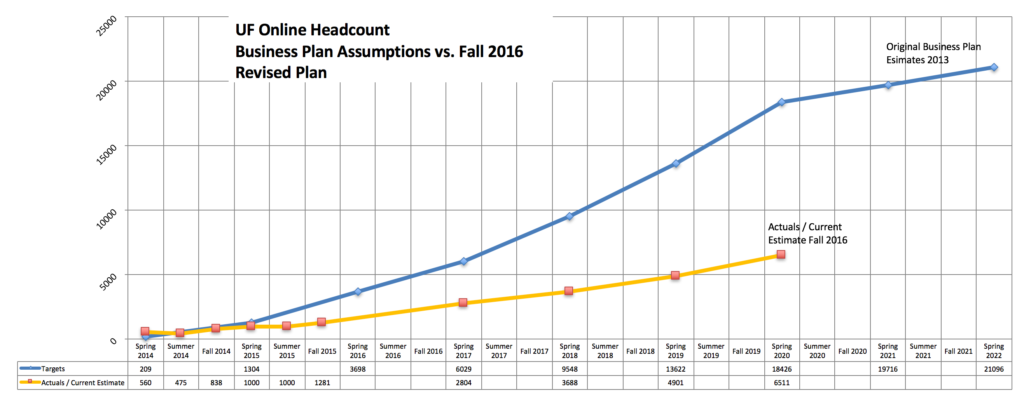The University of Florida, based on a plan created by the state legislature, started UF Online in 2013. The original business plan was a case study in optimistic enrollment planning and the road-to-riches through online education. From program inception, UF Online was forecast to grow to a headcount of 24,000 students within 10 years, 43% of whom would be out-of-state high-tuition students, generating $76 million in annual revenue and $14 million of “profit”. Then reality hit. The first executive director quit, enrollment reality did not match plans, they got rid of their Online Program Management partner (Pearson), and they hired a new executive director with no higher education management experience. In my May 2015 coverage, I concluded:
UF Online seems to be institutionally-focused rather than student-focused, and the initiative is shaping up to be a case study in hubris. Without major changes in how the program is managed, including the main campus input into decisions, UF Online risks becoming the new poster child of online education failures. I honestly hope they succeed, but the current outlook is not encouraging.
In a remarkable transformation in the past year originally described at Inside Higher Ed, UF Online appears to have made “major changes to how the program is managed” and is now focusing on students and reality.
Some of the key changes:
- The original plan called for an unrealistic growth of enrollment to 24,000+ students within 10 years, with 43% coming from out-of-state. These assumptions were based on the fact that out-of-state students pay triple the tuition that in-state students pay. With the revised plan, the program is now forecasting 6,500 students in year 7 (compared to 18,000 students at that same point from the business plan), with 11% coming from out-of-state. This forecast is believable.
- The original plan had the online students, who pay 75% of in-state tuition compared to those on-campus, not being able to use any of the campus services. Even for those students who lived in and around Gainesville, the plan was to not allow usage of campus services, sporting event tickets, etc. As of Spring 2016, UF Online now allows students to pay additional fees to be treated like an on-campus student. It’s an expensive fee that costs more than $690 per semester for full-time students, but at least they have to option to use campus services.
- The initial reaction to missing enrollments was to create PaCE – a pathway that allows qualified students not admitted to the traditional campus to enroll in UF Online for two years then transfer to face-to-face program. One element of that plan was to specifically “to populate major areas of study that have been under-enrolled in recent years”. With the revised business plan, there is a new focus on student needs and targeted investment (page 7):
Separately, where we see peak demand and limited capacity, UF Online has been able to divert costs savings to fund additional faculty salaries in the departments with the greatest demand. Ultimately, this strategic use of our funds better supports our faculty and students through high-quality online course content.
There is much more to read in the business plan revisions and 2015-2016 Annual report, but the real transformation we are seeing is a change in mindset. Even with the lower enrollment projects, if UF Online can meet the new plan’s targets (and this now seems quite realistic), we will now have a viable online program that can serve as a model for other schools. Kudos to Evangeline Cummings, the UF Online executive director with no previous higher ed management experience, for leading this transformation. They still have a lot of work to do but now seem to be on track.

[…] The Remarkable Transformation at UF Online […]